Frontline health workers in Uganda have been asked to adopt the double mask-up strategy while at work as an additional measure to contain the rising cases of coronavirus infection in the country.
In a circular issued to health workers on 7th June 2021, the Scientific Advisory Committee under the Ministry of Health told all health workers in the country to start using two masks in clinics and hospital wards in order to minimize the risk of catching COVID-19.
Double masking is when you layer one mask on top of another for extra protection against infection.
Uganda is currently battling a second wave of the COVID-19 pandemic; more virulent and spreading faster than the first.
Dr Henry Mwebesa, The Director General for Medical Services says by nature of their work, health workers interact with many patients daily putting them at a higher risk of contracting COVID-19.
“This therefore is to request you to double-mask up while at work. Please ensure that you wear two masks properly, and also adhere to the infection, prevention, and control measures to prevent contracting COVID-19” Dr Mwebesa said.
Uganda has so far reported 383 confirmed COVID-19 deaths with more than a dozen fatalities being health workers.
Advantages of Double masking
Many types of masks don’t fit perfectly on your face. In fact, you’ve probably noticed that you feel air escaping through the sides of your mask when you breathe in and out. This imperfect seal can not only allow respiratory droplets containing the virus to escape your mask, but it can also allow them in. Double masking can help to better prevent this from happening.
Two better than One
The strategy can have two advantages including better fit and increased filtration; when you’re wearing two masks, the outer mask can apply gentle pressure to the edges of the inner mask. When this happens, the inner mask fits more closely against your skin and creates a better seal.
SARS-CoV-2 is mainly spread through respiratory droplets that are made when someone who’s contracted the virus talks
coughs, or sneezes. With a mask on, the material in a tissue filters respiratory droplets containing the virus before you can inhale them. The layers of a mask help to increase its filtration power.
In fact, the Centers for Disease Control and Prevention (CDC) Trusted Source recommends using a face mask with at least two or three layers of fabric. Therefore, adding a second mask can improve filtration even more; because, it effectively doubles the layers of material that virus-containing respiratory droplets have to travel through before reaching your face and mouth.
How to double mask
Use the proper mask combination. The CDC Trusted Source recommends layering a cloth mask over a surgical mask.
Avoid other mask combinations. Some mask combinations may not improve fit or may make it hard to breathe. Combining of the two surgical masks, a KN95 and any other type of mask, an N95 and any other type of mask, is not advisable.
Try out your double mask at home before using it in public and make sure that the outer mask helps press the inner mask close to your face, forming a seal. To do this, cup your hands over your mask and feel for air escaping from the edges as you breathe.
While breathing may require a little extra effort when you’re double masking, it shouldn’t make breathing difficult. Make sure that your double mask doesn’t block your vision. Evaluate the situation; If you can maintain a distance of at least 6 feet from others outside your household, a single mask can give good protection.
A double mask can be beneficial when you’re going shopping, visiting the doctor, traveling with others outside your household (such as by plane, train, or public transportation) or working a job where you cannot maintain physical distancing.
NB: Some information has been sourced from trusted online sites -Editor
